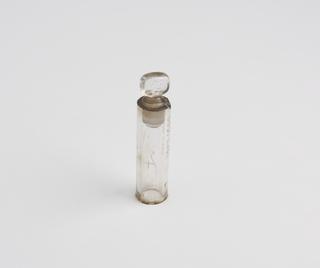


Gas cylinder mounted on octagonal base
1800-1850

Glass cylinder, with glass stopper
1800-1850

Ivory solid cylinder, 6ozs troy, with 4 brass hooks

Ivory solid cylinder, 4ozs troy, with 4 brass hooks

Glass cylinder; brass base; milled screw
1800-1899

Glass cylinder, ground on outside
1800-1899

1000 c.c. measuring cylinder with narrow neck

Old vertical cylinder frictional electrical machine
1765-1769

Small cylinder with one side tubulure

Iron solid cylinder
1761

Glass cylinder, 25ml, with polythene stopper and N.P.L. certificate

Glass cylinder, 100ml, with polythene stopper and N.P.L. certificate

Glass cylinder, 1000ml, with polythene stopper and N.P.L. certificate

Hydrogen cylinder, spare, for Safety lamp: Gray type
1893-1899

Carved hollow wood cylinder
1890-1913

Two inclined cylinders for centre of gravity demonstrations
1762

Glass cylinder, ground both ends
1750

Glass cylinder with wax seal
1750

Glass cylinder, ground on outside
1800-1899

Small cylinder from early Anzani aero engine

Aluminium motor cycle cylinder
1980

Beige plastic cylinder surrounded by clear plastic

Copper cylinder used by James Joule

Small cylinder with one side tubulure

Twenty cubic foot oxygen cylinder
Gas cylinder swivel mounted on trunion stand
1800-1850
Compressed Air Cylinder and Gauge
Aluminium-jacketted cylinder for aero engine
Boxwood cylinder
Wood and brass cylinder for demonstrating the difference in thermal conductivity
1900-1980
Cylinder with nozzles and bottom cover
Ten cubic foot sectioned acetylene cylinder
Cylinder head of the Ruston high compression airless atomiser oil engine
Glass storage cylinder containing black poppy seeds
Small glass measuring cylinder with pouring lip and scale, English, 1850-1900
1850-1900
Clear Glass Cylinder
Clear cylinder
Glass cylinder
Sectioned steel cylinder for CO2 Compressor
Glass cylinder
Ruby cylinder
Double cylinder electrical machine
1800
Two measuring cylinders
Two Cylinders of Six-Cylinder 300 H.P. Diesel Engine, ex German Submarine
Six semi-solid boxwood cylinders 1" long x 1 1/2" diameter
Glass cylinder with a closed end and tapering neck
Multi-knife cylinder
1975-1985
Oxygen and hydrogen cylinder
1895
Cylinder from PECO injection moulding machine
1950